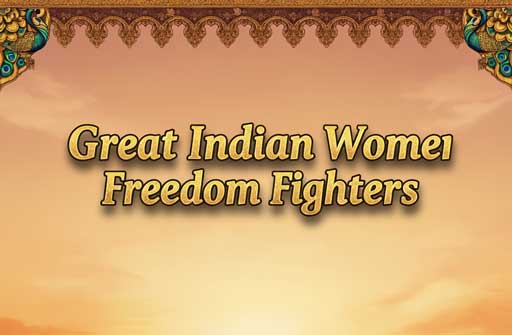Great Indian Women Freedom Fighters and Reformers
India’s freedom struggle and social reform movements were greatly enriched by the courage and sacrifice of many brave women. These inspirational leaders not only fought against British rule but also worked tirelessly for women’s education, social equality, and empowerment.
➤ Rani Lakshmibai of Jhansi
Rani Lakshmibai, born as Manikarnika, was one of the leading figures in the 1857 Revolt. She fought valiantly against the British in Gwalior and became a symbol of bravery and patriotism. Her fearless spirit continues to inspire generations of women even today.
➤ Savitribai Phule
Born in 1831 in Maharashtra, Savitribai Phule was India’s first woman teacher and a pioneer in women’s education. Along with her husband Jyotiba Phule, she fought against caste discrimination and opened schools for girls from oppressed communities. She also led the Satyashodhak Samaj and worked selflessly during the plague epidemic, feeding and helping thousands.
➤ Annie Besant
In 1916, Annie Besant founded the Home Rule League in Madras to demand self-governance for Indians. She edited journals like Commonweal and New India, spreading nationalist ideas. In 1917, she became the first woman President of the Indian National Congress, inspiring leaders like Nehru, Tilak, and Malaviya.
➤ Matangini Hazra
Matangini Hazra played a crucial role in the Civil Disobedience Movement (1932) and later in the Quit India Movement (1942). She was martyred while carrying the Indian flag, symbolizing the ultimate sacrifice for her country.
➤ Madam Bhikaji Cama
Inspired by Dadabhai Naoroji and Shyamji Krishna Varma, Madam Cama established the Free India Society in London and published the Vande Mataram newspaper. In 1907, she unfurled the first version of the Indian tricolor in Germany. She is fondly remembered as the Mother of Indian Revolutionaries.
➤ Kamaladevi Chattopadhyay
Kamaladevi Chattopadhyay joined the Salt Satyagraha with Gandhi and founded the Seva Base for women volunteers. She established the Sangeet Natak Akademi and the All India Handicrafts Board, promoting India’s cultural arts. She was also the first woman to contest elections in the Madras Presidency.
➤ Sarojini Naidu
Known as the “Nightingale of India”, Sarojini Naidu was the first Indian woman to preside over the Indian National Congress (1925) and later became the first woman Governor of India (Uttar Pradesh). She was a close associate of Gandhi and a key leader in the Civil Disobedience Movement. Her birthday is celebrated as National Women’s Day.
➤ Usha Mehta
During the Quit India Movement, Usha Mehta established an underground radio station, “Congress Radio,” which played a vital role in spreading Gandhi’s messages. She later wrote Mahatma Gandhi and Humanism and received the Padma Vibhushan in 1998.
➤ Aruna Asaf Ali
A fearless freedom fighter, Aruna Asaf Ali participated in the Salt Satyagraha and later led the Quit India Movement. She edited the Congress Socialist journal Inquilab and was posthumously awarded the Bharat Ratna in 1997.
➤ Durgabai Deshmukh
Durgabai Deshmukh actively participated in the Salt Satyagraha and Quit India Movement. She founded the Andhra Mahila Sabha in 1929 to promote women’s empowerment and education, playing a major role in social reforms.
➤ Kasturba Gandhi
Kasturba Gandhi, the wife of Mahatma Gandhi, stood by him during his struggle against racial injustice in South Africa and India. She participated in various civil movements and endured imprisonment several times, becoming a symbol of patience and strength.






